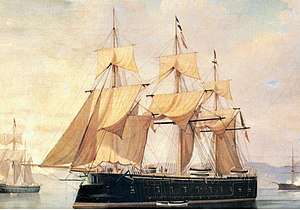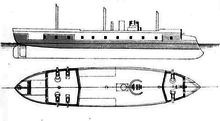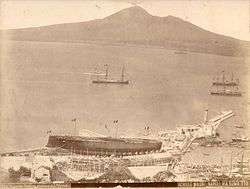Italian ironclad Principe Amedeo
Principe Amedeo was an ironclad warship built by the Italian Regia Marina in the 1860s and 1870s. She was the lead ship of the Principe Amedeo class, alongside her sister ship Palestro. Principe Amedeo was laid down in 1865, launched in 1872, and completed in late 1874. She was armed with a battery of six 10 in (254 mm) guns and one 11 in (279 mm) gun. The last sail-rigged ironclad of the Italian fleet, she had a single steam engine that was capable of propelling the ship at a speed of slightly over 12 knots (22 km/h; 14 mph).
 Painting of Principe Amedeo from the 1880s | |
| History | |
|---|---|
| Name: | Principe Amedeo |
| Namesake: | Prince Amedeo |
| Laid down: | August 1865 |
| Launched: | 15 January 1872 |
| Completed: | 15 December 1874 |
| Stricken: | 1900 |
| Fate: | Sold for scrap, 1910 |
| General characteristics | |
| Class and type: | Principe Amedeo-class ironclad warship |
| Displacement: |
|
| Length: | 79.73 m (261 ft 7 in) |
| Beam: | 17.4 m (57 ft 1 in) |
| Draft: | 7.9 m (25 ft 11 in) |
| Installed power: |
|
| Propulsion: | One single-expansion steam engines |
| Speed: | 12.2 knots (22.6 km/h; 14.0 mph) |
| Range: | 1,780 nmi (3,300 km) at 10 kn (19 km/h; 12 mph) |
| Complement: | 548 |
| Armament: |
|
| Armor: |
|
Principe Amedeo's lengthy construction time rendered her obsolescent by the time she entered service. As a result, she primarily served as a station ship in Italy's overseas empire. In November 1881, she collided with the ironclad Roma in a storm in Naples. Principe Amadeo was withdrawn from service in 1888 and converted into a headquarters ship for the vessels defending Taranto. She was stricken from the naval register in 1895 and thereafter used as a depot ship until she was broken up for scrap in 1910.
Design

Principe Amedeo was 79.73 meters (261 ft 7 in) long between perpendiculars; she had a beam of 17.4 m (57 ft 1 in) and an average draft of 7.9 m (25 ft 11 in). She displaced 5,761 long tons (5,853 t) normally and up to 6,020 long tons (6,120 t) at full load. Her propulsion system consisted of one single-expansion steam engine that drove a single screw propeller, with steam supplied by six coal-fired, cylindrical fire-tube boilers. Her engine produced a top speed of 12.2 knots (22.6 km/h; 14.0 mph) at 6,117 indicated horsepower (4,561 kW). She could steam for 1,780 nautical miles (3,300 km; 2,050 mi) at a speed of 10 knots (19 km/h; 12 mph). The ship was barque-rigged to supplement the steam engine; Principe Amedeo and her sister were the last rigged ironclads to be built by Italy. She had a crew of 548 officers and men.[1]
Principe Amedeo was armed with a main battery of six 10 in (254 mm) guns, mounted in a single armored casemates placed amidships, with three guns on each broadside. A 11 in (279 mm) gun was mounted forward as a bow chaser. Principe Amedeo was protected by iron belt armor that was 8.7 in (221 mm) thick and extended for the entire length of the hull. The casemates were protected with 5.5 in (140 mm) of iron plating, and the small conning tower had 2.4 in (61 mm) thick iron plates.[1]
Service history

Principe Amedeo was laid down at the Arsenale di La Spezia in August 1865, and her completed hull was launched on 15 January 1872. Fitting-out work proceeded very slowly, and the ship was finally completed on 15 December 1874.[1] Obsolescent by the time she was completed, Principe Amedeo primarily served in the Italian colonial empire,[2] which Italy had begun acquiring in the 1880s.[3] She occasionally took part in training maneuvers with the main Italian fleet throughout her career.[2]
Principe Amedeo took part in the launching ceremony for the ironclad Italia on 29 September 1880; also present were the Italian ironclad Regina Maria Pia and King Umberto I aboard his yacht, and the British ironclads HMS Monarch and Thunderer with Vice Admiral George Tryon, both members of the Mediterranean Fleet. At the time, Principe Amedeo flew the flag of Vice Admiral Martini.[4] In early November 1881, Principe Amedeo was moored in Naples when a severe storm tore the ironclad Roma free from her anchors and knocked her into Principe Amedeo. Neither ship was damaged in the collision.[5]
For the annual fleet maneuvers held in 1885, Principe Amedeo served as the flagship of the "Eastern Squadron", with Rear Admiral Civita commanding. She was joined by the ironclad Castelfidardo, the corvette Amerigo Vespucci, a sloop, and four torpedo boats. The "Eastern Squadron" defended against an attacking "Western Squadron", simulating a Franco-Italian conflict, with operations conducted off Sardinia.[6] During the exercises, Principe Amedeo was forced to "surrender" by the ironclad Caio Duilio.[7]
From 1888 to 1889, Principe Amedeo was employed as the headquarters ship for the forces defending Taranto.[1] By this time, she had been equipped with six 2.9 in (74 mm) guns for close-range defense, six machine guns, and two torpedo tubes.[8] The ship was stricken from the naval register on 28 March 1895 and thereafter used as an ammunition depot ship in Taranto. She was eventually broken up for scrap in 1910.[1]
Notes
- Gardiner, p. 340
- Ordovini et al., p. 358
- Pakenham, p. 280
- Fitzgerald, p. 163
- "Stray Foreign Facts" (PDF). The New York Times. 23 November 1881.
- Brassey, p. 141
- Brassey, p. 144
- Clowes, p. 376
References
- Brassey, Thomas A., ed. (1886). "Evolutions of the Italian Navy, 1885". The Naval Annual. Portsmouth: J. Griffin & Co.
- Clowes, W. Laird (1905). The Naval Pocket-Book. London: W. Thacker & Co.
- Fitzgerald, Charles (1897). Life of Vice-Admiral Sir George Tryon, K.C.B. London: William Blackwood and Sons.
- Gardiner, Robert, ed. (1979). Conway's All the World's Fighting Ships: 1860–1905. London: Conway Maritime Press. ISBN 0-85177-133-5.
- Ordovini, Aldo F.; Petronio, Fulvio; Sullivan, David M. (December 2014). "Capital Ships of the Royal Italian Navy, 1860–1918: Part I: The Formidabile, Principe di Carignano, Re d'Italia, Regina Maria Pia, Affondatore, Roma and Principe Amedeo Classes". Warship International. Vol. 51 no. 4. pp. 323–360. ISSN 0043-0374.
- Pakenham, Thomas (1992). The Scramble for Africa: White Man's Conquest of the Dark Continent from 1876 to 1912. New York: Perennial. ISBN 978-0-380-71999-0.